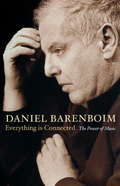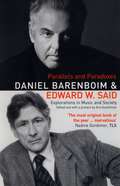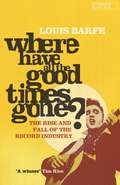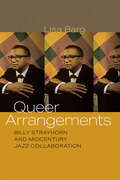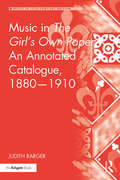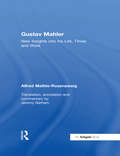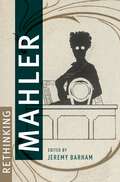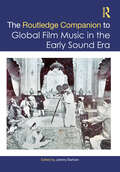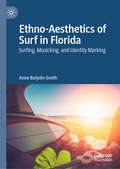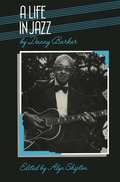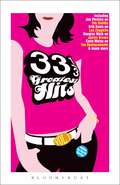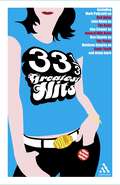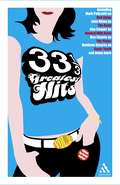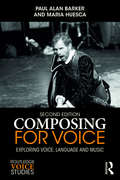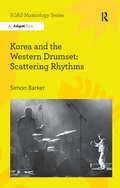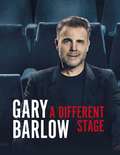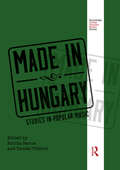- Table View
- List View
Everything Is Connected: Power Of Music
by Daniel BarenboimA memoir by the master pianist, conductor and internationalist Daniel Barenboim - 'the closest thing that classical music can offer to Nelson Mandela' [THE TIMES] 'The power of music lies in is its ability to speak to all aspects of the human being-the animal, the emotional, the intellectual, and the spiritual. Music teaches us, in short, that everything is connected' Daniel Barenboim’s new book vividly describes his lifelong pursuit of knowledge and understanding, not only of music and of life, but of one through the other.
Parallels & Paradoxes: Explorations in Music and Society
by Daniel Barenboim Edward SaidIsraeli Daniel Barenboim, one of the finest musicians of our times, and Palestinian Edward Said, eminent literary critic and leading expert on the Middle East, have been close friends for years. Parallels and Paradoxes is a series of discussions between the two friends about music, politics, literature and society. Barenboim and Said talk about, among other subjects, the differences between writing prose and music; the compromising politician versus the uncompromising artist; Beethoven as the ultimate sonata composer, Wagner (Barenboim is considered by many to be the greatest living conductor of his work); great teachers; and the power of culture to transcend national differences. Illuminating and deeply moving, Parallels and Paradoxes is an affectionate and impassioned exchange of ideas.
Where Have All the Good Times Gone?: The Rise And Fall Of The Record Industry
by Louis BarfeLouis Barfe's elegantly written, authoritative and highly entertaining history charts the meteoric rise and slow decline of the popular recording industry. Barfe shows how the 1920s and 1930s saw the departure of Edison from the phonograph business he created and the birth of EMI and CBS. In the years after the war, these companies, and the buccaneers, hucksters, impresarios and con-men who ran them, reaped stupendous commercial benefits with the arrival of Elvis Presley, who changed popular music (and sales of popular music) overnight. After Presley came the Beatles, when the recording industry became global and record sales reached all time highs. Where Have All The Good Times Gone? also charts the decline from that high-point a generation ago. The 1990s ushered in a period of profound crisis and uncertainty in the industry, encapsulated in one word: Napster. Barfe shows how the almost infinite amounts of free music available online have traumatic and disastrous consequences for an industry that has become cautious and undynamic.
Queer Arrangements: Billy Strayhorn and Midcentury Jazz Collaboration (Music / Culture)
by Lisa BargThe legacy of Black queer composer, arranger, and pianist Billy Strayhorn (1915–1967) hovers at the edge of canonical jazz narratives. Queer Arrangements explores the ways in which Strayhorn's identity as an openly gay Black jazz musician shaped his career, including the creative roles he could assume and the dynamics between himself and his collaborators, most famously Duke Ellington, but also iconic singers such as Lena Horne and Ella Fitzgerald. This new portrait of Strayhorn combines critical, historically-situated close readings of selected recordings, scores, and performances with biography and cultural theory to pursue alternative interpretive jazz possibilities, Black queer historical routes, and sounds. By looking at jazz history through the instrument(s) of Strayhorn's queer arrangements, this book sheds new light on his music and on jazz collaboration at midcentury.
Music in The Girl's Own Paper: An Annotated Catalogue, 1880-1910 (Music in Nineteenth-Century Britain)
by Judith BargerNineteenth-century British periodicals for girls and women offer a wealth of material to understand how girls and women fit into their social and cultural worlds, of which music making was an important part. The Girl's Own Paper, first published in 1880, stands out because of its rich musical content. Keeping practical usefulness as a research tool and as a guide to further reading in mind, Judith Barger has catalogued the musical content found in the weekly and later monthly issues during the magazine's first thirty years, in music scores, instalments of serialized fiction about musicians, music-related nonfiction, poetry with a musical title or theme, illustrations depicting music making and replies to musical correspondents. The book's introductory chapter reveals how content in The Girl's Own Paper changed over time to reflect a shift in women's music making from a female accomplishment to an increasingly professional role within the discipline, using 'the piano girl' as a case study. A comparison with musical content found in The Boy's Own Paper over the same time span offers additional insight into musical content chosen for the girls' magazine. A user's guide precedes the chronological annotated catalogue; the indexes that follow reveal the magazine's diversity of approach to the subject of music.
Music in The Girl's Own Paper: An Annotated Catalogue, 1880-1910 (Music in Nineteenth-Century Britain)
by Judith BargerNineteenth-century British periodicals for girls and women offer a wealth of material to understand how girls and women fit into their social and cultural worlds, of which music making was an important part. The Girl's Own Paper, first published in 1880, stands out because of its rich musical content. Keeping practical usefulness as a research tool and as a guide to further reading in mind, Judith Barger has catalogued the musical content found in the weekly and later monthly issues during the magazine's first thirty years, in music scores, instalments of serialized fiction about musicians, music-related nonfiction, poetry with a musical title or theme, illustrations depicting music making and replies to musical correspondents. The book's introductory chapter reveals how content in The Girl's Own Paper changed over time to reflect a shift in women's music making from a female accomplishment to an increasingly professional role within the discipline, using 'the piano girl' as a case study. A comparison with musical content found in The Boy's Own Paper over the same time span offers additional insight into musical content chosen for the girls' magazine. A user's guide precedes the chronological annotated catalogue; the indexes that follow reveal the magazine's diversity of approach to the subject of music.
Perspectives on Gustav Mahler
by Jeremy BarhamGustav Mahler's music continues to enjoy global prominence, both in live or recorded performance and within broader ranges of critical perception and cultural sensibility. In recognition of such a profile, this volume brings together a unique collection of essays exploring the diverse methods and topics characteristic of recent advances in Mahler scholarship. The book's international group of contributors is actively involved not only in bringing fresh approaches to Mahler research in areas such as analysis, sketch studies and reception history, but also in examining hitherto neglected issues of cultural and biographical interpretation, performance practice and compositional aesthetic, thereby illustrating the developing vitality and scope of this field. Engaging with its subject from reconstructive, documentary, theoretical, analytical, discursive and interpretative viewpoints, this volume provides a wide spectrum of contexts in which continuing debate about Mahler's life and works can flourish. Its varied themes and strategies nevertheless collectively recognize and negotiate the shifting space both between the composer's life and his artistic creativity, and between the musical results of that creativity and the critical-analytical process. The essays in this book accordingly fill certain gaps in the scholarly understanding of the composer, and re-orientate Mahler studies towards some of the central concerns of contemporary musicological thinking.
Perspectives on Gustav Mahler
by Jeremy BarhamGustav Mahler's music continues to enjoy global prominence, both in live or recorded performance and within broader ranges of critical perception and cultural sensibility. In recognition of such a profile, this volume brings together a unique collection of essays exploring the diverse methods and topics characteristic of recent advances in Mahler scholarship. The book's international group of contributors is actively involved not only in bringing fresh approaches to Mahler research in areas such as analysis, sketch studies and reception history, but also in examining hitherto neglected issues of cultural and biographical interpretation, performance practice and compositional aesthetic, thereby illustrating the developing vitality and scope of this field. Engaging with its subject from reconstructive, documentary, theoretical, analytical, discursive and interpretative viewpoints, this volume provides a wide spectrum of contexts in which continuing debate about Mahler's life and works can flourish. Its varied themes and strategies nevertheless collectively recognize and negotiate the shifting space both between the composer's life and his artistic creativity, and between the musical results of that creativity and the critical-analytical process. The essays in this book accordingly fill certain gaps in the scholarly understanding of the composer, and re-orientate Mahler studies towards some of the central concerns of contemporary musicological thinking.
Rethinking Mahler
by Jeremy BarhamAs one of the most popular classical composers in the performance repertoire of professional and amateur orchestras and choirs across the world, Gustav Mahler continues to generate significant interest, and the global appetite for his music, and for discussions of it, remains large. Editor Jeremy Barham brings together leading and emerging scholars in the field to explore Mahler's relationship with music, media, and ideas past and present, addressing issues in structural analysis, performance, genres of stage, screen and literature, cultural movements, aesthetics, history/historiography and temporal experience. Rethinking Mahler counterbalances prevailing scholarly assumptions and preferences that configure Mahler as proto-modernist, with hitherto neglected consideration of his debt to, and his re-imagining of, the legacies of his own historical past. Over the course of 17 chapters drawing from a variety of disciplinary perspectives, the book pursues ideas of nostalgia, historicism and 'pastness' in relation to an emergent modernity and subsequent musical-cultural developments, yielding a wide-ranging exploration and re-evaluation of Mahler's works, their historical reception and understanding, and their resounding impact within diverse cultural contexts. Rethinking Mahler will be an essential resource for scholars and students of Mahler and late Romantic era music more generally, and will also find an audience among the many devotees of Mahler's music.
The Routledge Companion to Global Film Music in the Early Sound Era (Routledge Music Companions)
by Jeremy BarhamIn a major expansion of the conversation on music and film history, The Routledge Companion to Global Film Music in the Early Sound Era draws together a wide-ranging collection of scholarship on music in global cinema during the transition from silent to sound films (the late 1920s to the 1940s). Moving beyond the traditional focus on Hollywood, this Companion considers the vast range of cinema and music created in often-overlooked regions throughout the rest of the world, providing crucial global context to film music history. An extensive editorial Introduction and 50 chapters from an array of international experts connect the music and sound of these films to regional and transnational issues—culturally, historically, and aesthetically—across five parts: Western Europe and Scandinavia Central and Eastern Europe North Africa, The Middle East, Asia, and Australasia Latin America Soviet Russia Filling a major gap in the literature, The Routledge Companion to Global Film Music in the Early Sound Era offers an essential reference for scholars of music, film studies, and cultural history.
Ethno-Aesthetics of Surf in Florida: Surfing, Musicking, and Identity Marking
by Anne Barjolin-SmithEthno-aesthetics of Surf in Florida discusses surf and music as glocal sociocultural constructs. Focusing on Florida's unexplored surfing culture, the book illustrates how musical experience begets representations about the world that highlight ways of acting and being of various sociocultural communities. Based on the conceptualization of ethno-aesthetics, this ethnographic study provides an analysis of the Space Coast surfers community's collaborative effort to build social cohesion through their musicking. This transdisciplinary research in American Studies draws upon various theoretical perspectives from both the humanities and social sciences, including ethnomusicology, social psychology, and sociolinguistics, to propose new ways of exploring the links between surfing and musicking. This monograph looks past the myth of iconic 1960s Californian surf music to show how, as a result of the glocalization of surfing, the musicking of Floridian surfers has allowed them to express their subjectivities and to make sense of their world. This book contributes to the debate on the disputed notions of identity and representations by establishing connections between a local expression of the surf lifestyle and its music. It proposes theoretical models that explain cultural hybridization, appropriation, and belonging in surfing. It also develops concepts and notions, such as surfanization, surf strand, lifestyle crossover, and identity marking, to illustrate how global practices, such as surfing, are endowed with various modes of expression exemplified by the emergence of unique regional subcultures of surfing.
The Pharcyde's Bizarre Ride II the Pharcyde (33 1/3)
by Andrew BarkerAs immediately believable as they were cartoonish, as much an inner city cipher as a suburban boys gang, the foursome that made up the Pharcyde were the most relatable MCs to ever pass the mic. On their debut and magnum opus Bizarre Ride II the Pharcyde, they created a record almost overstuffed with possibility, the sound of four restless man-children fresh out of their teens, finding a perfect outlet in a form of music that was just as young and fertile.And like the product of any adolescent, Bizarre Ride wears its contrarianism and contradictions on its sleeve. It's a party album about shyness and unrequited love. A swirl of jubilant L.A. psychedelia recorded in the midst of the Rodney King trial. A blast of black consciousness that still makes room to poke fun at Public Enemy and reference the Pixies. A dense, sophisticated sonic stew punctuated by yo mama jokes and prank calls. While hip-hop was already calcifying its tropes of steely machismo and aspirational fantasy, Bizarre Ride was a pure distillation of the average hip-hop listener's actual lifestyle-the joys and sorrows of four guys who were young, broke, sexually frustrated, and way too clever for their own good. A touchstone for Kanye West, Drake, Lil B and a whole generation of off-center MCs, Bizarre Ride sketched out a whole strata of emotions that other rappers hadn't yet dared to tackle, and to a certain extent, still haven't.
The Pharcyde's Bizarre Ride II the Pharcyde (33 1/3)
by Andrew BarkerAs immediately believable as they were cartoonish, as much an inner city cipher as a suburban boys gang, the foursome that made up the Pharcyde were the most relatable MCs to ever pass the mic. On their debut and magnum opus Bizarre Ride II the Pharcyde, they created a record almost overstuffed with possibility, the sound of four restless man-children fresh out of their teens, finding a perfect outlet in a form of music that was just as young and fertile.And like the product of any adolescent, Bizarre Ride wears its contrarianism and contradictions on its sleeve. It's a party album about shyness and unrequited love. A swirl of jubilant L.A. psychedelia recorded in the midst of the Rodney King trial. A blast of black consciousness that still makes room to poke fun at Public Enemy and reference the Pixies. A dense, sophisticated sonic stew punctuated by yo mama jokes and prank calls. While hip-hop was already calcifying its tropes of steely machismo and aspirational fantasy, Bizarre Ride was a pure distillation of the average hip-hop listener's actual lifestyle-the joys and sorrows of four guys who were young, broke, sexually frustrated, and way too clever for their own good. A touchstone for Kanye West, Drake, Lil B and a whole generation of off-center MCs, Bizarre Ride sketched out a whole strata of emotions that other rappers hadn't yet dared to tackle, and to a certain extent, still haven't.
A Life in Jazz
by Danny Barker Alyn ShiptonAs a musician who grew up in New Orleans, and later worked in New York with the major swing orchestras of Lucky Millinder and Cab Calloway, Barker is uniquely placed to give an authoritative but personal view of jazz history. In this book he discusses his life in music, from the children's 'spasm' bands of the seventh ward of New Orleans, through the experience of brass bands and jazz funerals involving his grandfather, Isidore Barbarin, to his early days on the road with the blues singer Little Brother Montgomery. Later he goes on to discuss New York, and the jazz scene he found there in 1930. His work with Jelly Roll Morton, as well as the lesser-known bands of Fess Williams and Albert Nicholas, is covered before a full account of his years with Millinder, Benny Carter and Calloway, including a description of Dizzy Gillespie's impact on jazz, is given. The final chapters discuss Barker's career from the late 1940s. Starting with the New York dixieland scene at Ryan's and Condon's he talks of his work with Wilbur de Paris, James P. Johnson and This is Jazz, before discussing his return to New Orleans and New Orleans Jazz Museum. A collection of Barker's photographs,
33 1/3 Greatest Hits, Volume 1 (33 1/3)
by David BarkerThe writings in this book are extracted from volumes 1 through 20 of our 33 1/3 series - short books about individual albums. In here you'll find a wide variety of authors, albums, and approaches to writing about those albums. So sit back, put on your headphones, cue up your favourite songs, and let our writers transport you to a time when: Dusty Springfield headed south to Memphis to record a pop/soul classic; The Kinks almost fell to pieces, and managed to make their best album while doing so; Joy Division and their mad, brilliant producer created a debut record that still sounds painfully hip today; James Brown mesmerized a sell-out crowd at the Apollo, in the midst of the Cuban Missile Crisis; The Rolling Stones shacked up in the South of France and emerged with one of the best double-albums ever; The Ramones distilled punk rock into its purest, most enduring essence... 33 1/3 Greatest Hits, Volume 1: it's like a compilation album, without the filler.
33 1/3 Greatest Hits, Volume 1 (33 1/3 #Volume 1)
by David BarkerThe writings in this book are extracted from volumes 1 through 20 of our 33 1/3 series - short books about individual albums. In here you'll find a wide variety of authors, albums, and approaches to writing about those albums. So sit back, put on your headphones, cue up your favourite songs, and let our writers transport you to a time when: Dusty Springfield headed south to Memphis to record a pop/soul classic; The Kinks almost fell to pieces, and managed to make their best album while doing so; Joy Division and their mad, brilliant producer created a debut record that still sounds painfully hip today; James Brown mesmerized a sell-out crowd at the Apollo, in the midst of the Cuban Missile Crisis; The Rolling Stones shacked up in the South of France and emerged with one of the best double-albums ever; The Ramones distilled punk rock into its purest, most enduring essence... 33 1/3 Greatest Hits, Volume 1: it's like a compilation album, without the filler.
33 1/3 Greatest Hits, Volume 2 (33 1/3)
by David BarkerThe second compendium of extracts from Continuum's acclaimed and successful 33 1/3 series, Volume 2 features 20 sharp, savvy and very different writers' takes on albums by Neutral Milk Hotel, Sonic Youth, My Bloody Valentine, David Bowie, the Pixies, the Beastie Boys, Nirvana, R.E.M, the Band and many more. A perfect gift for the music lover in your life!
33 1/3 Greatest Hits, Volume 2 (33 1/3 #Volume 2)
by David BarkerThe second compendium of extracts from Continuum's acclaimed and successful 33 1/3 series, Volume 2 features 20 sharp, savvy and very different writers' takes on albums by Neutral Milk Hotel, Sonic Youth, My Bloody Valentine, David Bowie, the Pixies, the Beastie Boys, Nirvana, R.E.M, the Band and many more. A perfect gift for the music lover in your life!
Composing for Voice: Exploring Voice, Language and Music (Routledge Voice Studies)
by Paul Barker Maria HuescaComposing for Voice: Exploring Voice, Language and Music, Second Edition, elucidates how language and music function together from the perspectives of composers, singers and actors, providing an understanding of the complex functions of the voice pedagogically, musicologically and dramatically. Composing for Voice examines the voice across a wide range of musical genres (including pop, jazz, folk, classical, opera and the musical) and explores the fusion of language and music that is unique to song. This second edition is enlarged to attract a wider readership amongst all music and theatre professionals and educators, whilst also engaging an international audience with the introduction of new co-author Maria Huesca. New to the second edition: A review of the history of singing An overview of the development of melisma A chapter to help performers understand each other, as singers and actors often receive disparate educations Case studies and qualitative research around song, lyric and meaning A discussion of the synthetic voice An introduction to the concept of embodied composition Interviews with composers and singers Summaries of various vocal styles A website with links to performances discussed, as well as related workshops: www.composingforvoice.com Composing for Voice: Exploring Voice, Language and Music, Second Edition, articulates possibilities for the practical exploration of language, music and voice by composers, singers and actors.
Composing for Voice: Exploring Voice, Language and Music (Routledge Voice Studies)
by Paul Barker Maria HuescaComposing for Voice: Exploring Voice, Language and Music, Second Edition, elucidates how language and music function together from the perspectives of composers, singers and actors, providing an understanding of the complex functions of the voice pedagogically, musicologically and dramatically. Composing for Voice examines the voice across a wide range of musical genres (including pop, jazz, folk, classical, opera and the musical) and explores the fusion of language and music that is unique to song. This second edition is enlarged to attract a wider readership amongst all music and theatre professionals and educators, whilst also engaging an international audience with the introduction of new co-author Maria Huesca. New to the second edition: A review of the history of singing An overview of the development of melisma A chapter to help performers understand each other, as singers and actors often receive disparate educations Case studies and qualitative research around song, lyric and meaning A discussion of the synthetic voice An introduction to the concept of embodied composition Interviews with composers and singers Summaries of various vocal styles A website with links to performances discussed, as well as related workshops: www.composingforvoice.com Composing for Voice: Exploring Voice, Language and Music, Second Edition, articulates possibilities for the practical exploration of language, music and voice by composers, singers and actors.
Korea and the Western Drumset: Scattering Rhythms (SOAS Studies in Music Series)
by Simon BarkerFor over a century, drummers have been turning to a variety of percussive traditions as prompts for the creation of new expressive possibilities on the drumset. In this book, Simon Barker sets out in detail the developmental processes he has followed creating an improvisational language for the drumset utilizing Korean rhythm/sticking cells, aesthetic conceptions, improvisatory codes, and developmental procedures. Barker offers historical overviews of Korean traditional rhythmic forms, analysis of rhythmic structures appearing in a variety of styles, an analysis and chronological account of his development of a 'Koreanized' approach to the drumset, a methodology for performing p’ansori accompaniment on the drumset, an introduction to Korean extended techniques, and a large collection of drumset studies based on Korean traditional forms such as tasÅrÅm, ch’ilch’ae, and ritual music structures from Korea’s East Coast. Barker also explores physical practices employed by Korean musicians which aid in the development of a relaxed, dynamic approach to performance. He creates a framework for creating an alternative approach to drumset education and performance through an engagement with Korea’s extraordinary rhythmic and aesthetic traditions. The volume includes an accompanying CD featuring recordings of developmental exercises, solo drumset improvisations, and ensemble performances, each track representing a subject of discussion within the volume.
Korea and the Western Drumset: Scattering Rhythms (SOAS Studies in Music Series)
by Simon BarkerFor over a century, drummers have been turning to a variety of percussive traditions as prompts for the creation of new expressive possibilities on the drumset. In this book, Simon Barker sets out in detail the developmental processes he has followed creating an improvisational language for the drumset utilizing Korean rhythm/sticking cells, aesthetic conceptions, improvisatory codes, and developmental procedures. Barker offers historical overviews of Korean traditional rhythmic forms, analysis of rhythmic structures appearing in a variety of styles, an analysis and chronological account of his development of a 'Koreanized' approach to the drumset, a methodology for performing p’ansori accompaniment on the drumset, an introduction to Korean extended techniques, and a large collection of drumset studies based on Korean traditional forms such as tasÅrÅm, ch’ilch’ae, and ritual music structures from Korea’s East Coast. Barker also explores physical practices employed by Korean musicians which aid in the development of a relaxed, dynamic approach to performance. He creates a framework for creating an alternative approach to drumset education and performance through an engagement with Korea’s extraordinary rhythmic and aesthetic traditions. The volume includes an accompanying CD featuring recordings of developmental exercises, solo drumset improvisations, and ensemble performances, each track representing a subject of discussion within the volume.
A Different Stage: The remarkable and intimate life story of Gary Barlow told through music
by Gary BarlowJoin national treasure Gary Barlow as he opens the curtains on his remarkable life in this stunning autobiography, from his fascinating early life to his star-studded music career'I just wanted to share my personal journey through the last five decades - the highs and lows, the ups and downs. So in A Different Stage, this is me opening the curtains and sharing moments nobody has heard or seen before . . .'__________In this warm, intimate and humorous book, rich with nostalgia and unexpected intimate detail, Gary Barlow unpacks the people, music, places, things and cultural phenomena that have made him the man that he is.From the working men's club where it all began through to the sold out stadium tours, this is the story of Gary's life told through music. Filled with a mixture of brand new photography from Gary's current one-man show and incredibly personal unseen photos and notebooks, A Different Stage is a beautiful book about the man we've spent our lives listening to.
Made in Hungary: Studies in Popular Music (Routledge Global Popular Music Series)
by Emília Barna Tamás TófalvyEmília Barna is Assistant Professor at the Budapest University of Technology and Economics. She is a founding member and Chair of IASPM Hungary, editor of Zenei Hálózatok Folyóirat (Music Networks Journal), and Advisory Board Member of IASPM@Journal. Tamás Tófalvy is Assistant Professor at the Budapest University of Technology and Economics. He was the founding Chair and is the current Vice-Chair of IASPM Hungary.
Made in Hungary: Studies in Popular Music (Routledge Global Popular Music Series)
by Emília Barna Tamás TófalvyEmília Barna is Assistant Professor at the Budapest University of Technology and Economics. She is a founding member and Chair of IASPM Hungary, editor of Zenei Hálózatok Folyóirat (Music Networks Journal), and Advisory Board Member of IASPM@Journal. Tamás Tófalvy is Assistant Professor at the Budapest University of Technology and Economics. He was the founding Chair and is the current Vice-Chair of IASPM Hungary.
